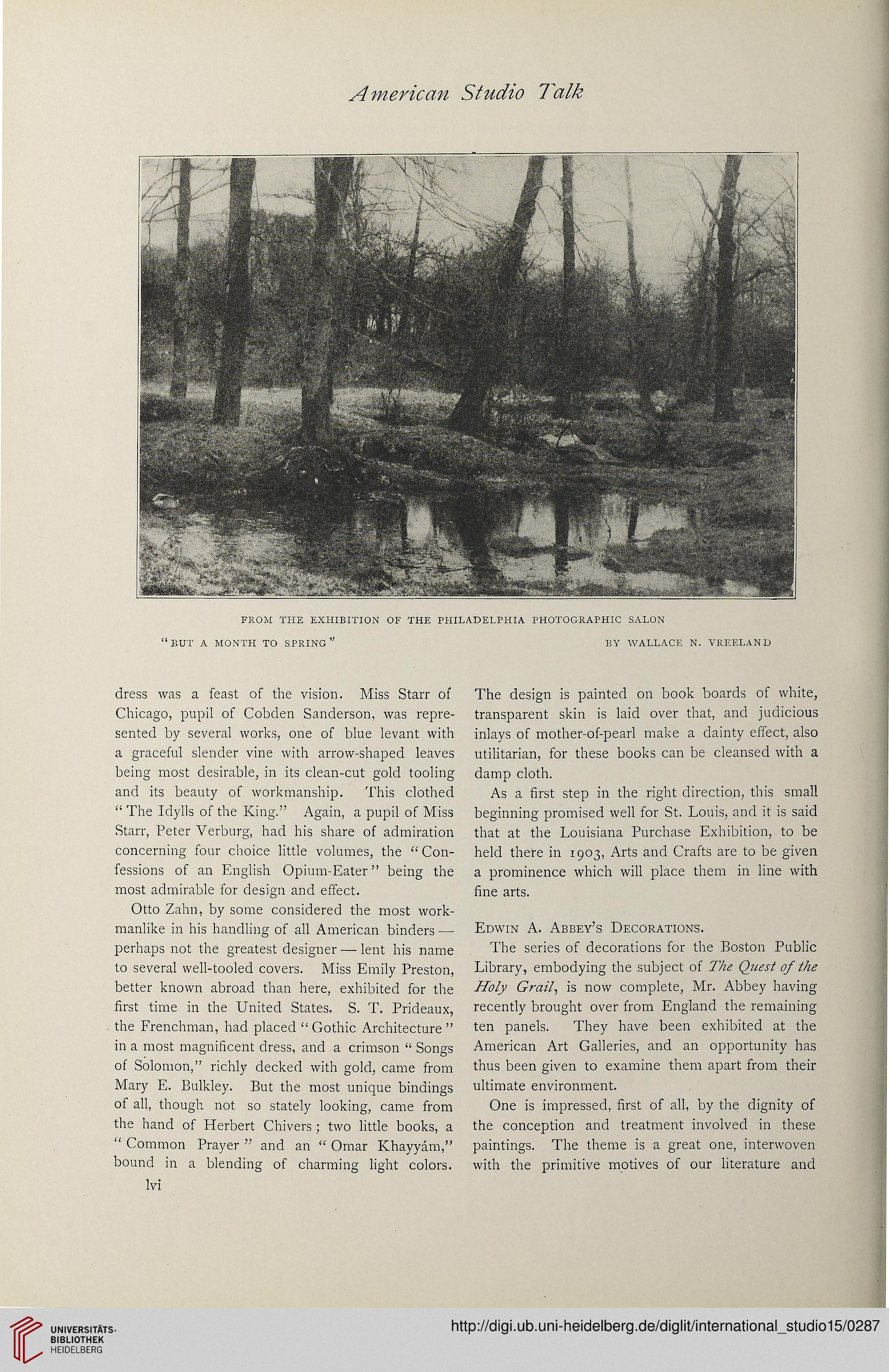A meric an Studio Talk
FROM THE EXHIBITION OF THE PHILADELPHIA PHOTOGRAPHIC SALON
“BUT A MONTH TO SPRING” BY WALLACE N. VREELAND
dress was a feast of the vision. Miss Starr of
Chicago, pupil of Cobden Sanderson, was repre-
sented by several works, one of blue levant with
a graceful slender vine with arrow-shaped leaves
being most desirable, in its clean-cut gold tooling
and its beauty of workmanship. This clothed
“ The Idylls of the King.” Again, a pupil of Miss
Starr, Peter Verburg, had his share of admiration
concerning four choice little volumes, the “Con-
fessions of an English Opium-Eater” being the
most admirable for design and effect.
Otto Zahn, by some considered the most work-
manlike in his handling of all American binders —-
perhaps not the greatest designer — lent his name
to several well-tooled covers. Miss Emily Preston,
better known abroad than here, exhibited for the
first time in the United States. S. T. Prideaux,
the Frenchman, had placed “Gothic Architecture ”
in a most magnificent dress, and a crimson “ Songs
of Solomon,” richly decked with gold, came from
Mary E. Bulldey. But the most unique bindings
of all, though not so stately looking, came from
the hand of Herbert drivers ; two little books, a
“ Common Prayer ” and an “ Omar Khayyam,”
bound in a blending of charming light colors,
lvi
The design is painted on book boards of white,
transparent skin is laid over that, and judicious
inlays of mother-of-pearl make a dainty effect, also
utilitarian, for these books can be cleansed with a
damp cloth.
As a first step in the right direction, this small
beginning promised well for St. Louis, and it is said
that at the Louisiana Purchase Exhibition, to be
held there in 1903, Arts and Crafts are to be given
a prominence which will place them in line with
fine arts.
Edwin A. Abbey’s Decorations.
The series of decorations for the Boston Public
Library, embodying the subject of The Quest of the
Holy Grail, is now complete, Mr. Abbey having
recently brought over from England the remaining
ten panels. They have been exhibited at the
American Art Galleries, and an opportunity has
thus been given to examine them apart from their
ultimate environment.
One is impressed, first of all, by the dignity of
the conception and treatment involved in these
paintings. The theme is a great one, interwoven
with the primitive motives of our literature and
FROM THE EXHIBITION OF THE PHILADELPHIA PHOTOGRAPHIC SALON
“BUT A MONTH TO SPRING” BY WALLACE N. VREELAND
dress was a feast of the vision. Miss Starr of
Chicago, pupil of Cobden Sanderson, was repre-
sented by several works, one of blue levant with
a graceful slender vine with arrow-shaped leaves
being most desirable, in its clean-cut gold tooling
and its beauty of workmanship. This clothed
“ The Idylls of the King.” Again, a pupil of Miss
Starr, Peter Verburg, had his share of admiration
concerning four choice little volumes, the “Con-
fessions of an English Opium-Eater” being the
most admirable for design and effect.
Otto Zahn, by some considered the most work-
manlike in his handling of all American binders —-
perhaps not the greatest designer — lent his name
to several well-tooled covers. Miss Emily Preston,
better known abroad than here, exhibited for the
first time in the United States. S. T. Prideaux,
the Frenchman, had placed “Gothic Architecture ”
in a most magnificent dress, and a crimson “ Songs
of Solomon,” richly decked with gold, came from
Mary E. Bulldey. But the most unique bindings
of all, though not so stately looking, came from
the hand of Herbert drivers ; two little books, a
“ Common Prayer ” and an “ Omar Khayyam,”
bound in a blending of charming light colors,
lvi
The design is painted on book boards of white,
transparent skin is laid over that, and judicious
inlays of mother-of-pearl make a dainty effect, also
utilitarian, for these books can be cleansed with a
damp cloth.
As a first step in the right direction, this small
beginning promised well for St. Louis, and it is said
that at the Louisiana Purchase Exhibition, to be
held there in 1903, Arts and Crafts are to be given
a prominence which will place them in line with
fine arts.
Edwin A. Abbey’s Decorations.
The series of decorations for the Boston Public
Library, embodying the subject of The Quest of the
Holy Grail, is now complete, Mr. Abbey having
recently brought over from England the remaining
ten panels. They have been exhibited at the
American Art Galleries, and an opportunity has
thus been given to examine them apart from their
ultimate environment.
One is impressed, first of all, by the dignity of
the conception and treatment involved in these
paintings. The theme is a great one, interwoven
with the primitive motives of our literature and




